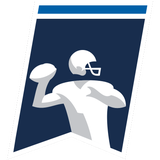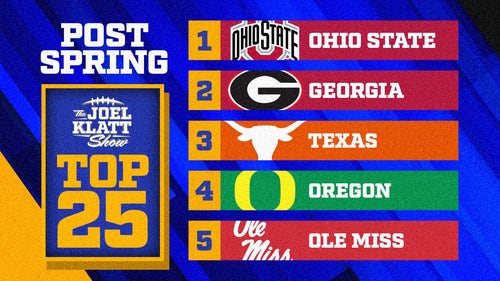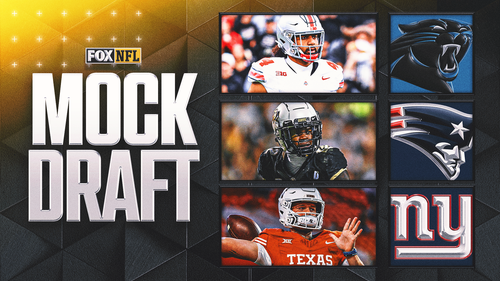
Football coaches call game-planning a science, but really it's an art
When it's time to find that perfect call in the heat of the moment, college football coaches within the Air Raid tree typically peruse nothing more than a flexible, half-folded piece of paper. USC coach Lincoln Riley is an extreme minimalist, his playsheet sometimes barely bigger than an index card.

USC coach Lincoln Riley takes a minimalist approach with his small playsheet on the sidelines. (Photo by Jayne Kamin-Oncea/Getty Images)
Ole Miss head coach Lane Kiffin has been trending toward the same brevity, slimming down his list of game-day calls from a double-wide Waffle House menu clone to a more manageable, double-sided A4. Both versions have managed to end up airborne to varying heights in anticipation of a touchdown. At the FCS level, Sacramento State's Troy Taylor has recently been utilizing an accordion fold to fit within one hand more easily.
On the other end of the spectrum, Jimbo Fisher bucks any trend toward downsizing, keeping the same setup for game days that he’s had since he first was handed play-calling duties. On top of his actual call sheet and a handful of loose papers, the Texas A&M coach is one of the few who totes a full spiral binder underneath — perfectly complementing his look of a veteran practitioner all the way down to a pair of reading glasses.
Clearly, this is a sport built on variety, and the differences even include the assortment of playsheets being held, thrown, or slammed down by coaches from coast to coast. They are the containers of knowledge for whatever matchup it might be, helping script (often literally in the first quarter) how contests will unfurl by turning multi-word strings of instructions into indelible moments that get etched into history.
But before the call goes from playsheet to headset, from coach to quarterback, from team to execution, it often starts in a darkened room lit up only by the glow of game film days, weeks, months or even years prior to Saturday. This is the art of game-planning.
'I can’t wait to go practice this'
It all starts with examining an opponent’s defense for the basics like alignments and potential weaknesses, detailing just what problems they pose as a unit or on an individual basis. Then comes sorting out what your own team’s strengths are. Finally, the resulting chess match of drawing up the right schemes to both exploit an opening as well as position players to be successful.
"I love game-planning," Stanford head coach David Shaw told FOX Sports. "That process, from Sunday really through Wednesday, of finalizing what we want to do on Saturday — it’s a lot of fun. I try not to cap (discussion on) anything other than volume. I want to make sure that everybody on our staff has a voice, has an opinion, and can contribute. I, of course, at the end of the day, have the final say at what’s in or what’s out.
"It’s part of what I love about the profession outside of game day. It’s my second favorite thing to do, to prepare and then present to our players what the plan for the week is."

Stanford head coach David Shaw has the "final say" on what plays make it into the Cardinal's game plan. (Photo by Bob Kupbens/Icon Sportswire via Getty Images)
A collective approach is a typical one for many college football programs and in the case of the Cardinal, is a process influenced by Shaw’s NFL background. Coaches break off into what they term "pods" to design the run game separately from the passing attack early in the week. They re-engage as a staff to merge the ideas together and form that upcoming game’s ever-evolving plan for players to digest and practice.
"When I was a receiver way back when and whenever I opened my playbook — and back then they were on paper — I’d say, ‘Oh wow, look at this one, this one looks like it’s for me.’ And this one looks like (coaches) knew what I did and what I can do and gave me this opportunity," added Shaw, who played on The Farm for Dennis Green and Bill Walsh. "That’s part of it, presenting players things, so they can say, ‘Oh wow, I can do that. That’s exciting, and I can’t wait to go practice this.’"
Benefits of continuity: ‘We think along the same lines’
Collaborative approaches among staff and players often benefit from continuity so that everybody knows what is expected from fall camp to bowl prep. Tavita Prichard was a former Stanford signal-caller but has risen up through the ranks of the program over the past 13 years, from a volunteer assistant to his current role as offensive coordinator.
Tennessee, which has the nation’s top-scoring offense at 50.1 points per game, is in a similar boat. Quarterbacks coach Joey Halzle has been with head coach Josh Heupel for 14 years, first as a player when the two were at Oklahoma together before coaching stops at Utah State, Missouri and UCF. Line coach Glen Elarbee has been in the group for six seasons.
"The coaches in our staff room have either played for me or been with me for an extended period of time. So we’re in the same system, we think along the same lines, but everybody’s able to bring ideas, and we can function at a high level," Heupel said. "That’s in game-planning but also in the course of a game, making subtle tweaks to what we’re doing to put our kids in the best position."
Heupel is also a testament to being flexible enough to evolve with the times as well. After all, he was originally brought to Oklahoma as a player from the junior college ranks to run the Air Raid by then-offensive coordinator Mike Leach, eventually finishing second for the Heisman Trophy and winning a national title with the Sooners in 2001.
Though Heupel’s current offense still has plenty of those same Air Raid concepts dating back to his days as a player, he’s also been able to successfully marry them with the field-stretching veer-and-shoot popularized at Baylor in the mid-2010s. Vols offensive coordinator Alex Golesh has been able to add further wrinkles to the playbook and helped supercharge the tempo the team operates at (nearly three plays per minute last season) since being hired on the same staff at UCF.
While Heupel has been calling plays since 2011 and contributes greatly in that department during games, the trust is so great on the staff at this point that Golesh is often the primary conduit taking things from concept during the week to most of the play calls that Heisman favorite Hendon Hooker is running on game day to great success.
A solution for every scenario
Finding that happy medium as a head coach heavily involved in the play-calling process can be tricky to manage given the time demands placed on the big chair nowadays.
Though there is more and more help, especially at bigger programs, the challenge remains the same at all levels and no matter who is eventually signaling things to an offense.
"I think the complexity of defenses has changed over the last, maybe eight years. The style of the backend coverage to adapt to spread football has changed quite a bit," Missouri’s Eli Drinkwitz said to FOX Sports. "I think now, for me, the biggest challenge is to make sure that not only am I focused on being the CEO of the program and the overall totality of what needs to occur in a game, but making sure I specifically give enough time and attention to making sure the offense has what it needs to be successful, too.
"That’s a balancing act that every day I try to grow and get better at."

At Missouri, coach Eli Drinkwitz uses a complex system to group plays into a situational playsheet. (Photo by James Gilbert/Getty Images)
Despite hinting this week that he might give up play-calling duties in the future, Drinkwitz still relishes the task of putting together the call sheet he takes into a game on Saturday just as he as first did upon landing a co-OC gig under Gus Malzahn back at Arkansas State. After other successful stints at Boise State, N.C. State and Appalachian State, the process for the head coach has been refined a little over the years but still comes back to the same approach as the staff translates hours of film preparation into a color-coded set of plays that are easy to find for every situation the offense might find itself in.
The Tigers focus first on base downs (first-and-10, second-and-6-or-less) to figure out their 12 best run designs and eight best pass plays. That all goes into one section. Then come plays for second-and-long, which on a typical week will result in four run plays and six pass plays repped in practice and added to the playsheet. Third-down plays receive plenty of scrutiny prior to a game and are broken up into sections for short (1-3 yards), medium (3-5 yards), long (6-9 yards) and extra-long (11-plus yards).
Now, layer on top of that other sections for downfield shots, screens, trick plays, "dirty runs" (obvious run situations), run-pass options (RPOs), red-zone plays and third-down plays in the red zone.
And that’s all just on one side of Drinkwitz’s playsheet.
"On the back is where we have our four-minute plan, our two-minute plan, our backed-up plan, our playmaker plan, our quarterback run plan and our middle eight plan," he said. "We divide those up and make sure that we’re prepared for those scenarios every game."
Perhaps it’s no wonder then that coaches almost universally lament that they’re limited to conveying it all to players in just 20 hours of work per week. Whether it’s what some might consider a simple system like Leach’s faithful Air Raid being run at Mississippi State or a more complex pro-style setup like the one Shaw runs at Stanford, trying to cram it all in with a new adversary each Saturday is a good reason why so much of the initial offensive install process takes place during camp, or even in the spring.
That way players at least have an idea of what to do even if they sometimes don’t even run a play for the first time until walkthroughs on Friday before taking the field.
When it comes to game-planning, the process is not just limited to what’s ahead on the radar for players and coaches either.

Texas A&M coach Jimbo Fisher and his staff self-scout their team every week during the season. (Photo by George Walker/Icon Sportswire via Getty Images)
"We self-scout every week no matter what. It’s exclusively formation, personnel, down and distance, everything. Always have," A&M’s Fisher added. "That’s a running ritual, to know as much about yourself as you do about your opponent. You’ve got to make sure of that."
That might be especially relevant to the Aggies not just because of their struggles on that side of the ball this season but due to Fisher having one of the more complicated offenses in the country to master. It has produced results in the form of a national championship at Florida State and a score of draft picks over the years but hasn’t quite taken root in College Station to the level many expected when he was first hired in 2018.
As Fisher looks for fixes in 2022, he doesn’t have to go that far for some answers — be it in meetings, during practice or when he’s calling plays during a game. That’s because every little nugget, insight or unique defensive look he sees over the course of planning for a Saturday in the SEC winds up right below his playsheet in that spiral of his that some have mistaken for the team’s actual playbook.
"It’s a notebook of things I do during the week, of all the notes and different situations. I can reference them back at halftime or between series," Fisher said of his setup. "I’ve done it ever since I’ve first coached. I used to do it when I was in the press box, (using) the notes you take as you watch film and of different formations and different personnel."
"Consistency is the key"
Referencing the past comes a little easier for others.
Prior to arriving at USC, Riley would often get quizzed during his weekly coach’s show back at Oklahoma about his essentially photographic memory of previous play calls. It’s a trait that has served him well over the years in leading some of college football’s most prolific offenses and might help explain why his playsheet is roughly the same size as just the third down calls on Fisher’s (if not smaller).
Such rapid-fire recall no doubt helps Riley understand what works in various situations — all while trying to react to a game that is constantly evolving and throwing curveballs in the form of even more exotic coverages in recent years.
Still, the crux of the matter in college football is distilling it all down quickly and simply enough for young players to translate it all between the lines into touchdowns.
"It’s really about the things that we can control, right? Our detail, our discipline, our ability to finish and execute plays," Florida coach Billy Napier said. "Consistency is the key. This is a game that requires 11 players doing their job to have success. Ultimately that’s what we’re looking for."
Perfection is rare, which is why this is a sport that can’t be boiled down into some scientific formula but is reflective of the artistic nature of calling plays.
How those ideas get from the coach's office to the field is as unique as college football itself.
Bryan Fischer is a college football writer for FOX Sports. He has been covering college athletics for nearly two decades at outlets such as NBC Sports, CBS Sports, Yahoo! Sports and NFL.com among others. Follow him on Twitter at @BryanDFischer.












































































































































